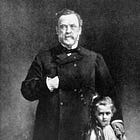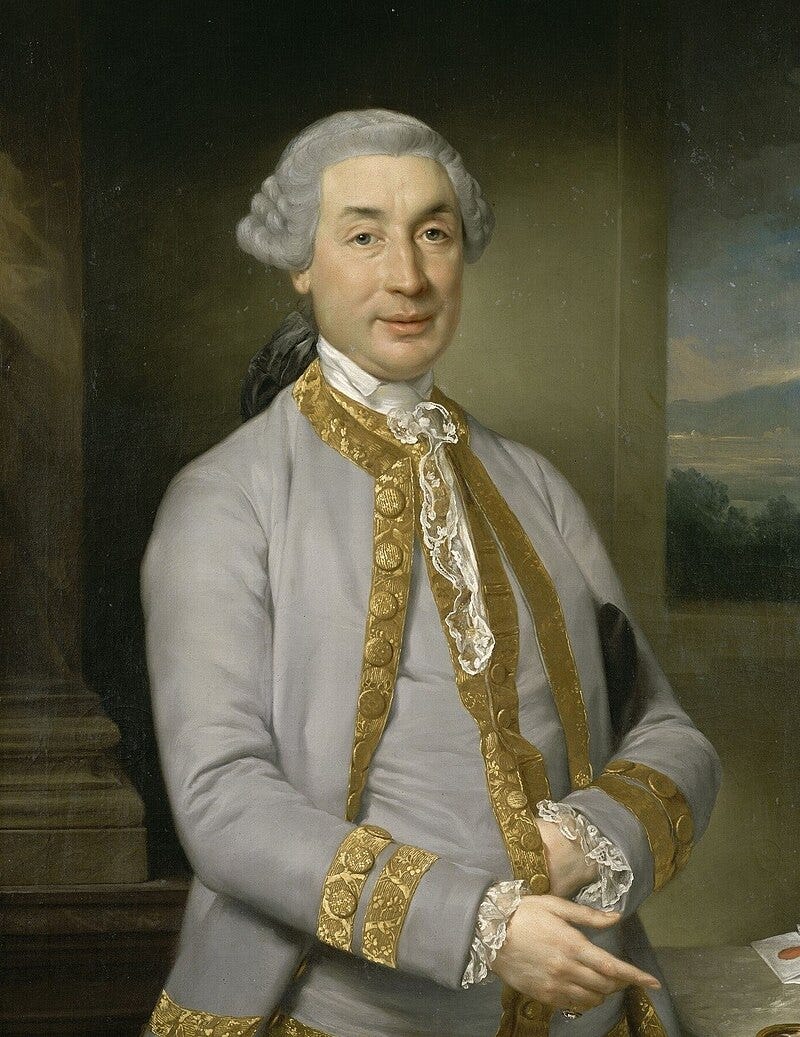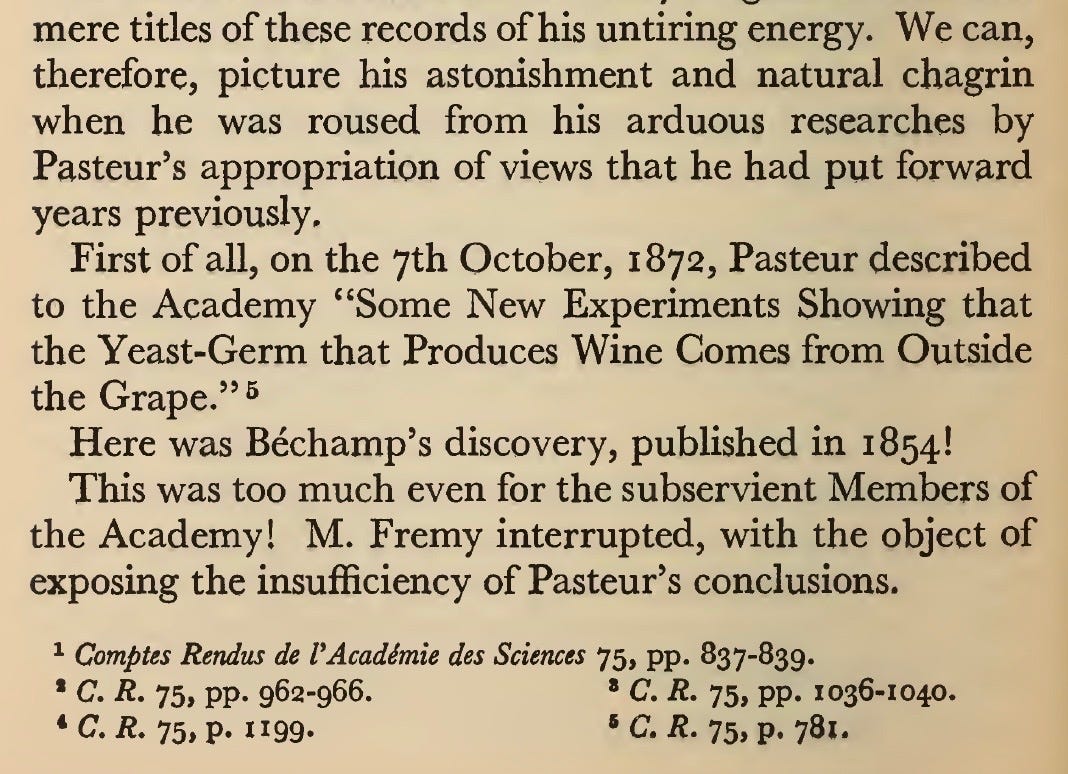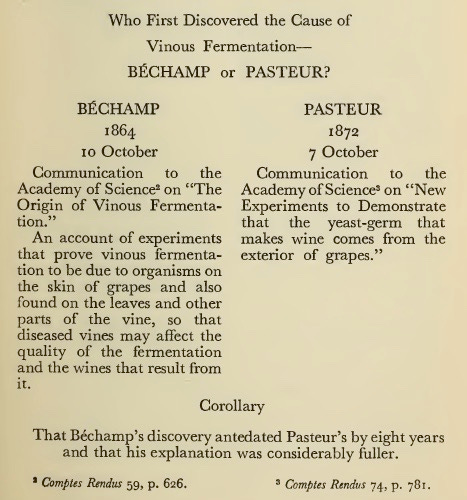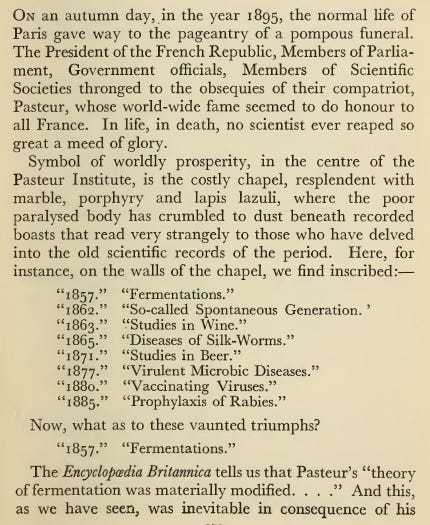Louis Pasteur the Fraudster, Part 2
Notes from Ethel Hume’s book, Bechamp or Pasteur
This article complements Part 1:
Most of the quotes below are from Ethel Hume’s 1923 book, Bechamp or Pasteur. Here is a copy with my highlights.
Since Louis Pasteur is considered the father of germ theory, we must zoom in closer and examine this man’s work and ideas, and by doing so, hope to gain a better understanding of what is taking place currently, with the perennial multi-booster push to fight ‘germs’. Hume recounts numerous examples of Pasteur’s plagiarism and jealousy of the brilliant scientist, Antoine Bechamp, who discovered microzymas, developed techniques for chemical industry, developed terrain theory, developed ideas about fermentation, the cause of pebrine and other diseases. This story of jealousy and rivalry between Pasteur and Bechamp would make a dramatic and archetypal movie.
Pasteur was a chemist by training, not a doctor of medicine or biologist.
When he took his degree of Bachelor of Science, his examiner appended a note to his diploma stating that he was only "mediocre in chemistry."
Contrast this with Antoine Bechamp, a professor of biology and doctor of medicine performing rigorous experiments:
For indeed this astonishing chapter denies the prevalent belief that Pasteur was the first to explain the mystery of fermentation, the cause of the diseases of silkworms, and the cause of vinous fermentation; moreover, it shows that his theories of micro-organisms differed in basic essentials from those of the observer who seems to have been the real originator of the discoveries to which Pasteur has always laid claim.
Hume details some of Bechamp’s work:
…his studies led him to the discovery of a new and cheap method of producing of aniline, which up to 1854 had been so costly as to be useless for commercial purposes.
he was the first really to establish the occurrence in, and distribution by, the atmosphere of micro-organisms, such as yeast, and to explain the direct agent in fermentation to be the soluble ferment secreted by the cells of yeast and other such moulds.
The explanation of the formation of urea by the oxidation of albuminoid matters and his clear demonstrations of the specificity of the latter formed only part of the strenuous labours that led to his discovery that the "molecular granulations" of the cells assist in fermentation, that they are autonomous entities, the living principle, vegetable and animal, the originators of bodily processes, the factors of pathological conditions, the agents of decomposition, while, incidentally, he believed them to be capable of evolving into bacteria. [Hume’s italics]
These ‘granulations’ are what Bechamp observed under the microscope and called ‘microzymas’. Gunther Enderlein later called these same granulations protits, and Gaston Naessens called them somatids. Barre Lando worked with Naessens, and this podcast with Mike Winner details Hume’s book:
There was a long history between Bechamp and Pasteur, from the 1850s to the 1880s:
He was suffering from the jealousy he had inspired in Pasteur and was smarting from the latter’s public attack upon him at the International Medical Congress in London, which they both attended in the year 1881. Such behaviour on the part of a compatriot before a foreign audience had seared the sensitive spirit of Bechamp and decided him to reply to Pasteur's plagiarisms. As he writes in the Preface to “The Microzymas”:- “The hour to speak has come!"
More on this incredible incident later.
From citing Pasteur’s published writings, namely in the Mimoire sur la fermentation appelee lactique from Comptes Rendus of the French Academy of Science, Nov. 30, 1857, Hume demonstrates that Pasteur should not have received credit for the process of fermentation, because he did not provide an explanation and because Bechamp had already provided the explanation a year before! Hume includes these quotes from Pasteur’s publication on souring milk:
"Fermentation shows itself to be correlative of life, of the organisation of globules, not of the death and putrefaction of these globules, still more that it does not appear as a phenomenon of contact." But this was only what others had said and had gone some way to prove years before him. So devoid was he of proof that he had to make the following admission in regard to his hypothesis that "the new yeast is organised, that it is a living being," namely:—"If anyone tells me that in these conclusions I am going beyond facts, I reply that this is true, in the sense that I frankly associate myself with an order of ideas that, to speak correctly, cannot be irrefutably demonstrated.”
We have, therefore, in Pasteur's own words, his confession of non-comprehension of a problem that the rigid experiments of another worker, Professor Bechamp, had already… solved by an irrefutable demonstration.
This absolute fraudster, in my italics above, just says trust me, it’s irrefutable! More instances of these cringey shenanigans below, but for now, here is that demonstration of the fermentation of cane sugar into glucose/grape sugar, from Bechamp’s ‘Beacon Experiment’ of 1855 and 1857 but published in 1858:
…cane-sugar was dissolved in distilled water in a glass bottle with an air-tight stopper, but containing a little air. This was left on the laboratory table at ordinary temperature and in diffused light. At the same time, control experiments were prepared. These consisted of solutions of similar distilled water and cane-sugar, to one of which was added a little zinc chloride, and to the others a little calcium chloride;
In Bechamp’s published words, the results showed that:
“Cold Water modifies Cane-Sugar only in Proportion to the development of Moulds, these Elementary Vegetations then acting as Ferments.”… “Moulds do not Develop when there is no Contact with Air and that no Change then takes Place in the Rotary Power”; also that “The Solutions that had Come in Contact with Air Varied in Proportion to the Development of Moulds.” The necessity of the presence of these living organisms for the processes of fermentation [by means of the acids they generated, which were regarded as “the soluble ferments.”] was thus shown clearly… "In these solutions there existed no albuminoid substance; they were made with pure cane-sugar, which, heated with fresh-slaked lime, does not give off ammonia. It thus appears evident that air-borne germs found the sugared solution a favourable medium for their development, and it must be admitted that the ferment is here produced by the generation of fungi."
Here, in direct contradiction to Pasteur's account of the spontaneous origin of beer-yeast and other organisms, Bechamp gave proof positive of Schwann's teaching of airborne germs, and further specified yeast to be of the order of fungi.
You would think that this type of information would be included in Gerald Geison’s biography of Pasteur, but it was not. Instead, as mentioned in my Part 1 article, Geison considers Hume’s Bechamp Or Pasteur to be a propaganda piece demeaning Pasteur’s work and that “it does not persuade me that Pasteur ‘plagiarized’ Bechamp’s work and ideas…” This leads me to believe that the Ivy League professor, Gerald Geison, is another gatekeeper, sugarcoating the level of fraud, plagiarism, and ineptitude of Pasteur as his book is the only English biography resulting from the research of Pasteur’s notebooks, much like how Hollywood establishes a narrative with historical movies.
Here is another demonstration of how Pasteur, considered by the establishment as one of the greatest scientists of all time, completely misunderstood Bechamp’s fermentation experiments:
Here is Dr. G. Archie Stockwell’s assessment of Pasteur’s science from 1886:
I must admit it is difficult to criticise the man fairly or justly, since his work for the most part consists of mere assertion. Again, no one can follow his work. Apparently he cannot follow it himself. Take any one of his utterances, and one is amazed to find a contradictory mass of statements, such as have never emanated from any other source. We discover no well-arranged, systematic records of study and experiment, along with data, facts, and conclusions carefully considered and worked out,—the usual evidences of the efforts of the true scientist ; but we find positive assertions to-day as positively controverted to-morrow, both overwhelmed and denied on the third occasion. Judged by any standard, it is impossible to accord him rank as a scientist…
Ouch! This all paints a picture of Pasteur as lacking the acumen and rigorous experimentation needed to prove his claims. However, what he did have was the support of the French Emperor at the time, Napoleon III:
For fortunate Pasteur, Imperial patronage was no dead letter. Four months after his presentation to Napoleon, in July of the same year, he received direct encouragement from the latter to turn his attention to the vinous diseases that were then interfering with the trade in French wines.
he received the honour of being invited as a guest to spend a week with the Emperor and Empress at the Palace of Compiegne.
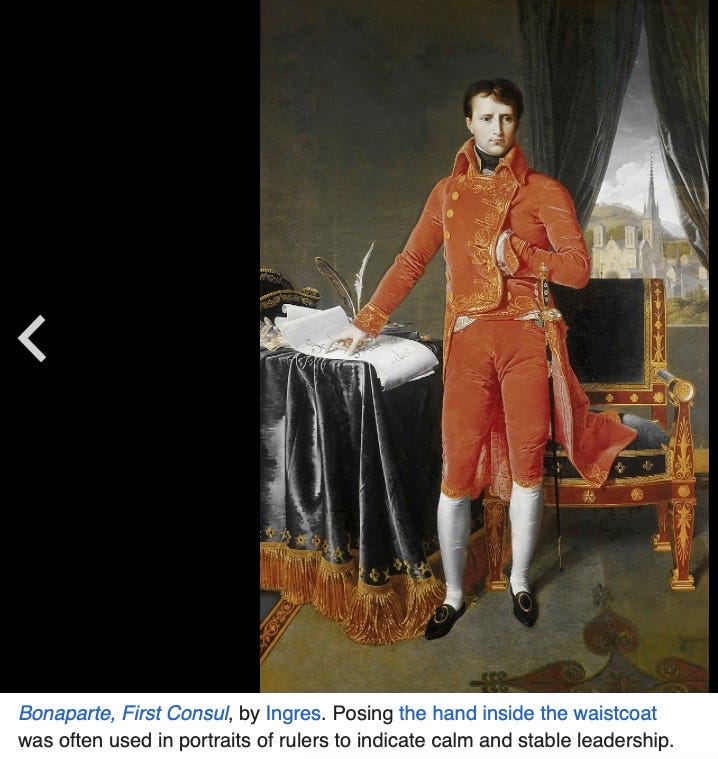
Kristen Welch has an excellent article on the establishment’s control of germ theory, including the Pasteur Institute, which was instrumental in establishing PCR protocols for ‘SARS-Cov-2’, among other so-called ‘viruses’:
The Institut Pasteur first got off of the ground in the late 1800’s thanks to Pasteur’s international petition for funding that was granted thanks to none other than the likes of donors such as Andrew Carnegie.
Hume continues to contrast Pasteur’s ineptitude and Bechamp’s brilliance. Bechamp’s note written to the French Academy of Sciences concludes that the silkworm disease affecting France at that time, Pebrine (because the larvae are covered in dark dots like black pepper), starts
“… from the outside and the germs of the parasite come from the air. The disease, in a word, is not primarily constitutional.” He went on to explain how he developed the eggs, or, as they are called, the seeds, of the silk-worms in an enclosure in which the odour of creosote [carbolic acid/phenol, which is effective at preventing the growth of molds] was produced from a very minute dose of the drug. The eggs, thus hatched, were all free from pebrine. As Professor Bechamp never committed himself to statements until he had proof positive, we find in this verdict upon pebrine the decisive clearness that characterises all his opinions.
Pasteur was still so much in the dark that he had not even the acumen to gauge the correctness of the views of the great teacher of Montpellier [Bechamp]. But this Note of Bechamp's was, no doubt, a trial to him. Here was another worker pronouncing upon a subject that had been officially relegated to him and hallowed by the blessing of the beautiful Empress. Accordingly, on the 23rd July, 1866, Pasteur unburdened himself of a Statement to the Academy of Science on the Nature of Pebrine. It was entitled "New Studies on the Disease of Silk-Worms." And here we must look for the great discovery said to have been provided by Pasteur for "the salvation of sericulture." It was this:—"The healthy moth is the moth free from corpuscles [the diseased bodies akin to cancerous cells in the silkworm]; the healthy seed [silkworm eggs] is that derived from moths without corpuscles." Such an obvious conclusion is laughable! Still, as it could not be condemned as incorrect, it would have been as well for Pasteur to have ventured no further. Instead, he proceeded: "I am very much inclined to believe that there is no actual disease of silk-worms. I cannot better make clear my opinion of silk-worm disease than by comparing it to the effects of pulmonary phthisis. My observations of this year have fortified me in the opinion that these little organisms are neither animalcules nor cryptogamic plants. It appears to me that it is chiefly the cellular tissue of all the organs that is transformed into corpuscles or produces them." Not a single proof did he bring forward of a fact that would, if true, have been marvellous: not a single suggestion did he give of any experiment to determine the asserted absence of life in the corpuscles or their relation to the disease. Finally he went out of his way to contradict Bechamp and in so doing set a definite seal on his blunder. "One would be tempted to believe, especially from the resemblance of the corpuscles to the spores of mucorina, that a parasite had invaded the nurseries. That would be an error"
This intentional dig at another worker was singularly unlucky, for it provides proof positive of the lie direct given by Pasteur to a correct solution to which he afterwards laid claim. Here was the man who had so utterly renounced his former sponteparist views as to ascribe all fermentative effects, all vital phenomena, to air-borne causes, now denying the extraneous origin of a disease that was proved by Bechamp to be undoubtedly parasitic.
Another example of Pasteur’s inept science:
As a safeguard to pebrine he put forward his system of taking seed only from moths free from corpuscles [the dark spots showing disease], which, as Bechamp pointed out, was an absurdity, considering the parasitic nature of the complaint and the fact that the parasites abounded on mulberry leaves.
Around this time in the late 1860s, when Bechamp and Pasteur were researching pebrine as well as another silkworm disease called flacherie, Hume notes Pasteur’s jealousy of Bechamp:
Pasteur was well acquainted with all the Notes [to the French Academy of Sciences] published by Bechamp, but, regrettably to say, had not the generosity to spare praise for his rival's great scientific triumph. It is undeniable that his thought was of himself and how he could best vindicate his own pretensions.
Hume also notes how Pasteur tried to claim himself as the discoverer of flacherie when in fact it was Bechamp:
On the 29th June, the Reports include a letter to M. Dumas from M. Pasteur dated 24th June, 1868, Paillerols, Commune de Mees, Basses-Alpes. Here it is extraordinary to find that he actually dared to claim that he had been the first to draw attention to this second silk-worm disease and distinguish it from pebrine. He wrote to M. Dumas:—"You know that I was the first . . ." But, no doubt, realising that the Academy Reports were destitute of any such proof, he demanded the insertion of the full text of a Note that he claimed to have sent on the 1st June, 1868, to the Agricultural Society of Alais. It was duly inserted with Pasteur's letter, and was entitled: "Note on the Silk-Worm Disease commonly known as Morts-Blanes or Morts-Flats [flacherie]."
Pasteur’s influence hindered Bechamp’s microzyma theory:
Perhaps the greatest harm occasioned by Pasteur's jealousy was the hindrance he set up to notice being taken of Bechamp's work, particularly in regard to his cell doctrine and microzymian theories. So much did Pasteur make it his effort to flout these ideas that, actually, Members of the Academy, influenced by friendly motives, begged Professor Bechamp to drop the very use of the word "microzyma"! Thus the misfortune came about that, instead of being encouraged, science was held back, and at every turn the Professor of Montpellier found himself hampered in the work that, so he believed, would lay the foundations of cytology and physiology and elucidate the processes of the anatomical elements in birth and life, in health and disease, in death and in disruption.
What Bechamp discovered was that these microzymas were everywhere “in all organic matter” and “they, not the cell, are the primary anatomical elements,” the autonomous building blocks of life:
making use at first principally of such organisms as yeast, found the granulations which they contain to be agents provocative of fermentations, and then bestowed on them the explanatory name of microzyma. These same granulations he found in all animal and vegetable cells and tissues…

the Professor instituted many experiments… to prove that the bacterial appearances were not due to external invasions.
In one particular instance where a patient’s injured elbow caused his forearm to be amputated:
Under a high power of the microscope, microzymas were seen associated and in chaplets, but no actual bacteria. These were merely in process of formation. The changes brought about by the injury had progressed too rapidly to give them time to develop. This evidence against bacteria as the origin of the mortification was so convincing that Professor Estor [Bechamp’s colleague] at once exclaimed: "Bacteria cannot be the cause of gangrene; they are the effects of it."
Although Pasteur was crucial in establishing germ theory for Big Pharma, Hume says Casimir Davaine “more or less inaugurated what is now known as the germ-theory of disease” through investigations with what is now known as ‘anthrax’, but was then called charbon or splenic fever in cattle.
A theory had already been put forward in the past by [Athanasius] Kircher, Linne, Raspail and others that special organisms might induce disease, and Davaine, becoming acquainted with Pasteur's idea that each kind of fermentation is produced by a specific germ of the air, now suggested that the little rod-like organisms, which he called bacteridia, might be parasitic invaders of animal bodies and the cause of splenic fever, otherwise anthrax. He and others, who tried to investigate the subject, met with contradictory results in their experiments. It was later, in 1878, that the German doctor, Robert Koch, came to their rescue by cultivating the bacteridia and discovering a formation of spores among them; while Pasteur finally took the matter up and with his fondness for dogmatising declared :—"Anthrax is, therefore, the disease of the bacteridium, as trichinosis is the disease of the trichina, as itch is the disease of its special acarus."
Bechamp states below that the germ theorists did not see the whole picture:
“…it is certain that there truly exist microscopic living beings of the most exquisite minuteness, which, undoubtedly, can communicate the specific diseased condition that is in them. The cause both of the virulence and the power of infection in certain products of the sick organism, or of bodies in a state of putrefaction after death, resides in reality in beings of this order. It is true that people have certainly discovered such beings during the development of certain complaints, virulent, infectious, contagious or otherwise.”
It is thus seen that it was Bechamp's belief that it is this particle of truth in the germ-theory that has blinded so many to its errors. He explains that the want of a fuller understanding is brought about by lack of sufficient knowledge.
Hume notes again the contradictory nature of Pasteur’s thinking when he wrote in Comptes Rendus de l’Academie des Sciences 56:
the body is nothing more than an inert mass, a mere chemical complex, which, while in a state of health, he maintained to be immune against the invasion of foreign organisms ["Le corps des animaux est ferme, dans Us cas ordinaires, d l'introduction des germes des etres infirieurs"]… How can foreign organisms originate disease in a body when, according to Pasteur, they cannot find entry into the self-same body until after disease has set in?
Hume continues along these lines with more examples of fermentation occurring within dead organisms not exposed to air, which would support Bechamp’s microzyma theory and goes against germ theory travelling through air. Hume details a controversial discussion in the Academy where the chemist Edmond Fremy accused Pasteur of arriving at the wrong conclusions from these assertions. And likewise, a disagreement with Jules Guerin, Vincent Richards, Auguste Trecul and later
he fell foul of another Member of the Academy of Medicine, Dr. Colin
as well as an ‘M. Peter’, about the Anthrax disease. Keep in mind that many other scientists did not want to encounter political issues by confronting the influential Pasteur’s tactics or reasoning.
The glowing panegyrics that surround the memory of the famous French chemist considerably obscure the disfavour in which his methods were held by many of his contemporaries.
Criticism also from Germany:
His biographer tells us:—"The sharpest attacks came from Germany." Dr. Koch and others disputed Pasteur's conclusions and dared to doubt the efficacy of his prophylactic against anthrax.
And from Italy, where a group of professors from the University of Turin attempted to replicate Pasteur’s anthrax vaccine experiments using his methodology, only to end up killing all of the sheep involved! After some exchanges and an agreement for Pasteur to come to Italy and perform the experiments, the Italians asked Pasteur for specifics to ensure exactitude and no ‘trickery’. So he chickened out and flat out lied about the Italians:
The astute Frenchman had now no simple innocents to deal with. He was requested to set down in black and white definite descriptive statements, which would be faced by hard facts and run the grave risk of being found wanting. This reasonable test of his views, which any scientist should have welcomed, was to him a trap, into which he had no intention of walking. The way of escape lay in throwing the onus on the Italians, and in a Communication to the Academy of Science, he actually dared to say:—"The Commission of Turin then does not accept my offer to go to them!" He was careful to keep from the Academy the letter he had received in which his suggestion was by no means declined, but merely made accessory to preliminary clear statements in regard to the proposed experimentation. What Pasteur, however, did not hesitate to do was to accuse the Commission of erroneous statements and quotations. His biographer is careful to avoid telling us that he was promptly challenged to point these out.
To defend themselves, the ‘Commision’ of professors published a response titled Of the Scientific Dogmatism of the Illustrious Professor Pasteur, detailing Pasteur’s lies. I cannot find this publication online.
With cutting irony, the Commission rejoiced with their illustrious opponent for having at last admitted that the inoculation of blood at once anthracised and septic could, according to the relations of the two taints in the blood doubly infected, produce sometimes pure anthrax, sometimes pure septicaemia, and sometimes anthrax and septicaemia combined. By this admission he destroyed his own dogma of the non-development of the bacillus of anthrax when it is associated with other organisms, aerobic or anaerobic. The Commission further congratulated themselves on having convinced M. Pasteur that he could not at Paris diagnose the complaint of an animal that had died at Turin, and they were glad that they had led to his reviewing his dogmas through the researches of his assistant, M. Roux, and recognising as erroneous the following principle laid down in his Communication of July, 1877: "The bacteria of anthrax may be profusely introduced into an animal without giving it anthrax. It will be sufficient if the bacteridia suspended in the liquid have at the same time the common bacteria associated with them."…
They sarcastically referred to his admission of septicaemias benign and malignant, "but it seems," they said, "that the vibrios of the benign septicaemias reside in Paris only and that in Italy they do not exist, because he has declared positively that the unfortunate animals which died as a result of our former experiment on the 23rd March, were killed by septicaemia…
Edmond Fremy, Jules Guerin, Vincent Richards, Auguste Trecul, and the Turin professors are not mentioned once in Gerald Geison’s biography, the Private Science of Louis Pasteur. Gabriel Colin and Michel Peter, however, are.
Then Hume details Pasteur’s blatant plagiarism of Bechamp’s and other’s works on fermentation when he addressed the Academy:
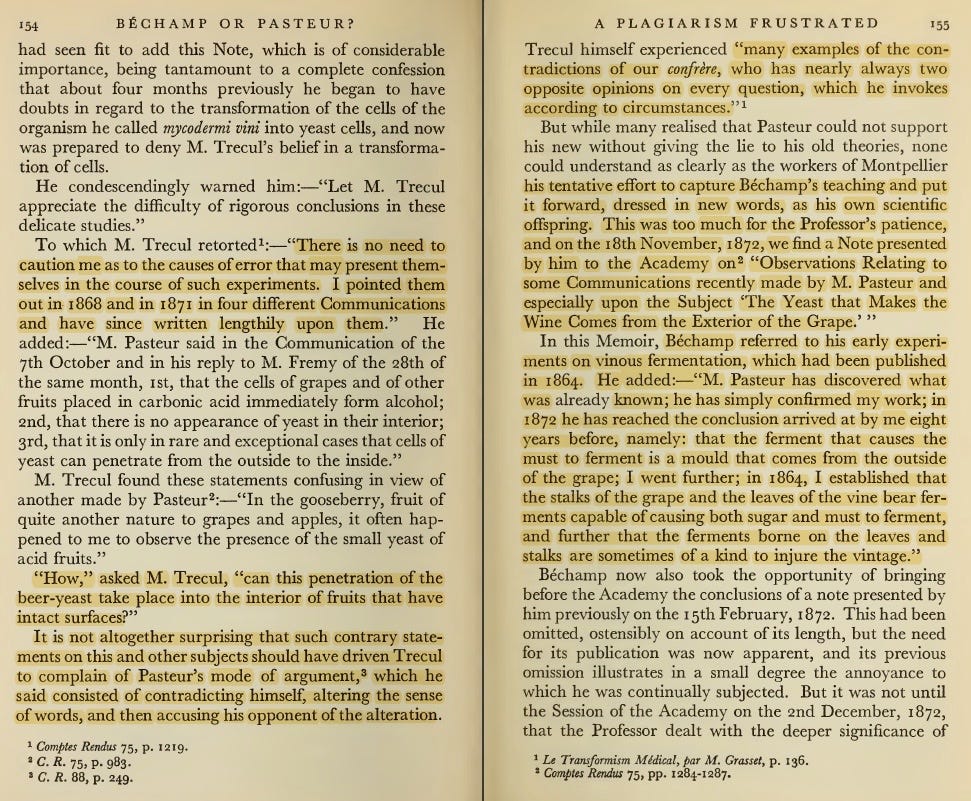
Bechamp’s response detailing that it was he, not Pasteur who developed theories on fermentation:
"Under the title 'New Facts to Forward the Knowledge of the Theory of Fermentations, Properly So-called,' M. Pasteur has published a Note, the perusal of which has interested me all the more in that I have found many ideas in it that have been familiar to me for a long time. My deep respect for the Academy and consideration for my own dignity impose upon me the obligation of presenting some observations on this communication, otherwise, people who are not in touch with the question might believe that I had imposed on the public by attributing to myself facts and ideas that are not mine."
He went on to show by dates and by quotations from numerous works that he had been the first to establish two essential points: 1st. That organised and living ferments could be generated in media deprived of albuminoid matter. 2nd. That the phenomena of fermentation by organised or "figured" ferments are essentially acts of nutrition.
After these incidents, Bechamp moved to Lille where the priests interfered with his work. Furthermore, Pasteur had enough influence to stigmatize Bechamp’s term, ‘microzyma’.
Meanwhile the establishment uses shills and fraudsters like Edward Jenner and Louis Pasteur to establish their nation-wide and now world-wide, multi-booster vaccination programs:
…Jenner, who bought his medical degree for £15, and Pasteur, who managed to obtain by a majority of just one vote a place among the Free Associates of the Academy of Medicine!
In another example of Pasteur and Bechamp disagreeing, only to have his Pasteur Institute admit, although it was after both had passed in 1914, that Bechamp was correct regarding the so-called anthrax bacillus, found when sheep and other cattle are sick, usually from arsenic dips:
his [Bechamp’s] claim that bacteria could change their forms, the rod-shape pass into the spheroid, etc. This was denied by Pasteur. None the less, after the passing of years, a worker at the very Institute that bears the latter's name has confirmed Bechamp's statement. [The book says Mme. Victor Henri.]
More on the establishment of germ theory and push for interstitial vaccines that bypass the liver’s filtering gateway:
He [Pasteur] also inaugurated the fashion for what may be called the study of artificial disease-conditions; that is to say, instead of giving attention to Nature's experiments in naturally diseased subjects, human and animal, the mania was aroused for inducing sickness by poisonous injections, a practice Pasteur started about this time [1870s, when Pasteur popularized germ theory], and which his followers have so persistently copied that some have even deliberately performed iniquitous experiments upon men, women and children. There can be no question that, since his day, bird and animal victims of every species have languished by millions all over the world in pathological laboratories…
Pasteur lost no time in pushing his views on anthrax and kindred subjects, and on the 30th April, 1878, read before the Academy of Science a Memoir bearing his own name and those of Messrs. Joubert and Chamberland. It was entitled "The Theory of Germs and their Application to Medicine and Surgery," and was the first lusty trumpetblast of the germ-theory of disease. Pasteur seized this good opportunity to advertise widely that he had discovered "the fact that ferments are living beings." It goes without saying that not one word of acknowledgment was made to Bechamp, for his wonderful illumination of the subject.
It is noteworthy that neither Pasteur nor any of his successors have ever induced a complaint by the inoculation of air-carried bacteria, but only by injections from bodily sources.
Pasteur's mind always turned to the business side of any proposition. He now saw ahead a chance of tangible profit and dreamed of a means of arresting, or professing to arrest, the ravages of anthrax among sheep and cattle. Using his classification of aerobic and anaerobic microorganisms, he proposed by a mixture of the two sorts to neutralize the virulence of the bacteridium. We have already seen how he regarded the accidental administration of some stale culture to hens as a guide to his subsequent proceedings, and it was for chicken-cholera that he first endeavoured to procure what he called a "vaccine." Professor Toussaint, of the Toulouse Veterinary School, worked at the subject of "vaccination" against anthrax, which Pasteur subsequently took up and announced himself satisfied that he had discovered a real preventive.
In May, 1881, Pasteur was invited to put his vaccine to the test at a farm near Melun, and in June he wrote home triumphantly that complete success had resulted. By this was meant that sheep that had been first inoculated with his preparation did not succumb to a subsequent dosage of poison. The test was artificial. No real success could be proved unless it was found that natural infection was powerless against inoculated animals. This objection was put forward and in July some experiments were undertaken that were supposed to satisfy it, since the power of the vaccine was tested by a subsequent injection of blood taken from a sheep that had actually died of anthrax. But here again it is obvious that the procedure was distinct from natural infection, especially as certain sheep remained impervious to the complaint although feeding on ground supposed to be pervaded by bacteria from the buried carcasses of diseased sheep. However, success seemed sufficient for a commercial asset to be made of the supposed prophylactic. It does not take much observation to note that pecuniary profits obstruct unbiased criticism, and thus real investigation was checked from the first by Pasteur's alliance of science with commercialism.
Pasteur arrived in London to fanfare at the International Medical Congress in August, 1881, as the French Republic’s representative. During one of the sectional meetings, he defamed Bechamp, who was also in attendance, to a point where he stood up to defend himself, only to have Pasteur leave the meeting:
This was when Pasteur, most unfairly, suddenly included his compatriot in his strictures against Sponteparists, speaking as though Bechamp were a believer in heterogenesis, instead of the real destroyer of the belief in spontaneous generation through his microzymian explanation of the presence of micro-organisms within internal organs and tissues.
The Times thus quotes Pasteur: —
"The same error was made in this respect by Dr. Bastian in England and Professor Bechamp in France. The latter was wholly mistaken, for instance, in his theory as to the existence of microzymas in chalk."
The Times, kind to the fashionable demagogue, leaves Pasteur's criticism at this; but what fired Bechamp's indignation was, as he tells us in his Preface to [Bechamp’s book] Les Microzymas, Pasteur's subsequent unpardonable accusation of plagiarism: —
"If there was anything exact in Bechamp's view-point, he had conceived it in assimilating his (Pasteur's) labours and modifying his ideas according to the other's."
Such a bare-faced reversal of facts was too much for long-suffering Professor Bechamp. He sprang from his seat and faced his traducer, indignantly demanding proofs and promising himself to supply them to establish the exact opposite.
Pasteur's behaviour cannot, we think, be condoned by even his most enthusiastic admirer. Confronted by his victim, he simply turned on his heel and quitted the assembly, defrauding Bechamp of all opportunity for a proper public vindication of himself and his discoveries.
As The Times has quoted the latter's speech, we can see for ourselves the contrast of the Professor's magnanimous and dignified treatment of Pasteur.
"Professor Bechamp of Lille, likewise speaking in French, affirmed that the microzymas in chalk did exist and that if M. Pasteur had not obtained such results, it was because his experiments were badly conducted. On other points also M. Bechamp contested M. Pasteur's views. He held that the cause of disease and of death lay in the animal itself. The so-called 'molecular granulations' of histologists were living organised things, endowed with chemical activity, and having the same functions as the similar granulations which existed in the air and in chalk under the name of microzymas; they were the primitive agents of the organisation and the chemical activity of living organisms, though, strange to say, these microzymas, while morphologically identical, exercised different functions in different organic centres and tissues, as, for instance, the microzymas of the pancreas compared with those of the liver.
Pasteur’s anthrax vaccine was first given on a mass scale in Odessa, Russia, with disastrous results:
…it was administered, according to Pasteur's description, to 4,564 sheep, of which number 3,696 were very soon dead.
Moreover, M. Rene Vallery-Radot, in his biography, tells us nothing of the private owners in France and elsewhere whom Pasteur had to compensate for animals killed by his vaccine. A special Commission in Hungary recommended the Government of that country to prohibit its use; Koch and Muller in Germany pronounced against it; the English Board of Agriculture declined to recommend it; while, finally, before the last Royal Commission on Vivisection, its protagonists could not do better than damn the modern "modified" edition with faint praise. Alas! for Pasteur and his pronouncement that "the only sovereign judge must be history!"
So then we come to his most famous enterprise, the Rabies vaccine:
"I call my method perfect."…
This test, introduced by Pasteur, is to take some matter, the saliva, blood, part of the brain or spinal cord, usually the cerebro-spinal fluid, from the suspected animal and inject it into a living rabbit. It is evident to common sense, apart from Bechamp's illuminating explanation, that matter from one creature introduced into another is likely to be injurious, and Vulpian, a French doctor and physiologist and a supporter of Pasteur, himself found that the saliva of healthy human beings killed off rabbits as quickly as the saliva of a child who had died of hydrophobia.
Hydrophobia is the original name for what is now considered ‘rabies’.
by weakening the virus from dogs (supposedly mad) by transmission through monkeys and by fortifying it again through rabbits, he had obtained something protective to dogs and which would eradicate rabies from the world. Considering that nothing then was, or now is, known of the cause of rabies, if regarded as a specific malady, as it was in Pasteur's opinion, surely such a boast savours very much of the "cure-alls" of quackery.
Like the Italian professors, more sarcasm toward Pasteur:
In a pamphlet Hydrophobia and Pasteur, by Vincent Richards, F.R.G.S., the author pertinently asks:—"Does the result that 15 or 16 out of the 20 dogs inoculated remained unaffected in any way warrant the assumption that the method adopted by Pasteur was protective?"
Pasteur then modified his vaccine with a crazier witch’s brew and the newspapers deemed this a success on Joseph Meister who then became famous:
On the 26th October, 1885, Pasteur described his later method of treatment, which was to take the spinal cords of rabbits that had received injections of virus, keep these for varying lengths of time, then beat them up, each with twice its own weight of sterilised bouillon, finally, commencing with the weakest, inoculate the patient for ten days successively. Moreover, he triumphantly pointed to a successful case, that of Joseph Meister, a little Alsatian boy, nine years old, who had been badly bitten by a dog on the preceding 4th July, 1885, and two days later was taken to Pasteur for treatment.
What ‘virus’ means here is unclear, and likewise any evidence of the dog having symptoms of rabies, and whether Meister even caught any disease. Meister’s wounds were cauterized by the doctors, which was a favored practice for bites at the time:
For the succeeding ten days, Joseph Meister was regularly inoculated, receiving in all about a dozen injections of the spinal cord dosage.
Now, in considering this case, we must ask what proof Pasteur had of the madness of the dog and probability of hydrophobia ensuing in the victim?
The rabid state of the animal was inferred by its savagery and the fact that a post-mortem examination disclosed "hay, straw and pieces of wood" in the stomach. The presence of the latter would seem far more likely to indicate that the dog had been ravenous, probably starving, a condition that, in itself, would have accounted for its savage behaviour. As to the boy, the number and severity of the bites he had received caused the doctors Vulpian and Grancher, who were called in, to decide that he was almost inevitably exposed to contract hydrophobia in consequence. Why? As we have seen, there wac no real proof of rabies in the dog that had attacked him. But, for argument's sake, granting that the animal had been mad, it must be remembered that the wounds had been cauterised.
…
other persons, including the dog's owner, Max Vone, bitten by the same dog as Meister and on the same day, who were neither cauterised nor treated by Pasteur, continued in good health.
…
Another child, Mathieu Vidau, inoculated by Pasteur and supposed to be cured, died seven months after treatment. To excuse the death of again another child, named Louise Pelletier, failure was attributed to the bites being on the head and too much time having elapsed after the bite before the inoculation…
…
A notable failure was that of a French postman, named Pierre Rascol, who, with another man, was attacked by a dog, supposed to be mad, but not bitten, for the dog's teeth did not penetrate his clothing; but his companion received severe bites. The latter refused to go to the Pasteur Institute and remained in perfect health; but unfortunate Rascol was forced by the postal authorities to undergo the treatment, which he did from the gth to the 14th March. On the following 12th April, severe symptoms set in, with pain at the points of inoculation, not at the place of the bite, for the reason that he had never been bitten. On April 14th, he died of paralytic hydrophobia, the new disease brought into the world by Pasteur.
…
The claim for Pasteur's success is based upon the assertion that he reduced the death-rate for hydrophobia from 16 per cent to 1 per cent. But the late Colonel Tillard has shown in a pamphlet called Pasteur and Rabies, that the 16 per cent theory of death-rate before Pasteur brought in his supposed preventive must be ridiculously wrong. As the yearly average number of deaths for France up to then had not been more than 30, the number of the bitten, according to the 16 per cent estimate, says Colonel Tillard, should have been less than 200; but Pasteur, on the contrary, had 1,778 patients during the year 1887, which meant, according to this calculation, that over 250 would have died had they not gone to him.
Similar evidence is presented for other regions, such as Zurich, Stockholm, Breslau, and Haiti. The deaths attributed to ‘hydrophobia’, as rabies was called back then, actually increased after Pasteur’s rabies vaccine was implemented, including King Alexander of Greece, who was bitten by a monkey and succumbed after given Pasteur’s rabies vaccine:
As the King instead, unhappily, grew rapidly worse, a discreet silence was, for the most part, observed as to his treatment, the truth as to which, however, we learn in a bulletin received by the Greek Legation in London and reported in the Daily Mail:—"Athens. Saturday. The King passed a critical night. His fever attained 105.6 deg. Fahr. and was preceded by severe shivering and accompanied by a fit of delirium, which lasted one hour and a half. This morning he was again vaccinated. His heart has weakened. His breathing is irregular.
Ah, but no mention of Pasteur’s rabies vaccine by Wikipedia for the account of King Alexandria of Greece’s death!
It is, to say the least of it, remarkable that definite curative measures should be overlooked and set aside for a mere preventive which cannot set forward a single tangible proof of ever having saved anyone, while, on the other hand, as we have seen, there is undeniable evidence that it has occasioned a new complaint, paralytic hydrophobia. For such procedure there must be some explanation and perhaps the Indian paper, The Pioneer, for March 12, 1919, unconsciously provides it: —
"The Central Research Institute at Kasauli has developed its vaccine production to an almost incredible extent. The yearly average before the war was 18,500 cubic centimeters; during the war it rose to over 21 million cubic centimeters, and included anti-typhoid, cholera, pneumonia and influenza vaccines. From a monetary point of view alone the value of the Kasauli vaccines for the period of the war was about half a million sterling."
Sound familiar? Problem, reaction, solution from the salivating, cold-blooded rulers of this realm. And this increase was just for a region of India, not the rest of the world.
Here are a couple of more interesting quotes from Bechamp or Pasteur:
It may be well to recall what happened when Dr. Charles Greighton was asked to write an article on vaccination for the Encyclopedia Britannica. He complied, but being a scientist in deed as well as in name, felt it incumbent first to study the subject. As a consequence, the article had to be condemnatory, for investigation proved vaccination to be "a grotesque superstition" in the opinion of the greatest of modern epidemiologists.
This incident of Charles Greighton was also documented in Dawn Lester’s and David Parker’s comprehensive book, What Really Makes You Ill, as was other information in this article, such as the anthrax vaccine numbers.
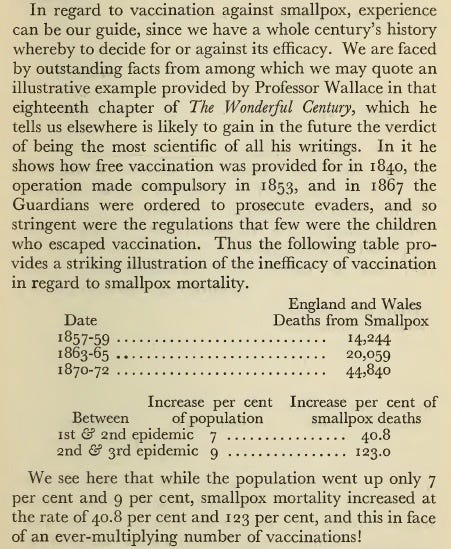
In conclusion, here are Pasteur’s ‘achievements’ listed in the Pasteur Institute, followed by what they actually amounted to:
It did not require much perspicacity to realise that if Pasteurian treatment could secure any appearance of success, the pecuniary advantages would be considerable. Thus Pasteur inaugurated the era that was to see the calamitous prostitution of science to commercialism. Bacteriological Institutes for experimentation upon living animals and for the production and sale of vaccines and sera came into being all over the world, modelled upon the one opened in 1888, in Paris.
It should be very clear having read these accounts of this total fraudster, Louis Pasteur, what is going on in this world regarding control and greed.
Thanks for reading.


